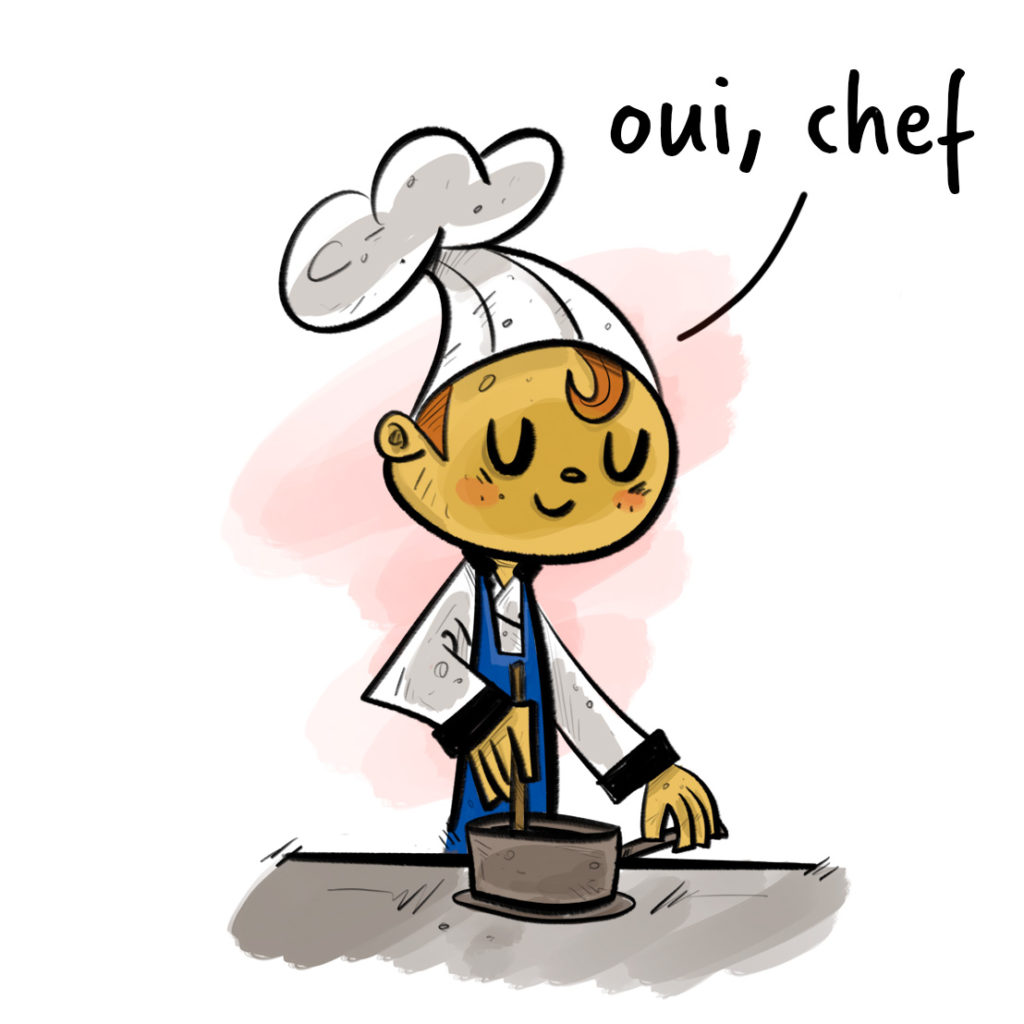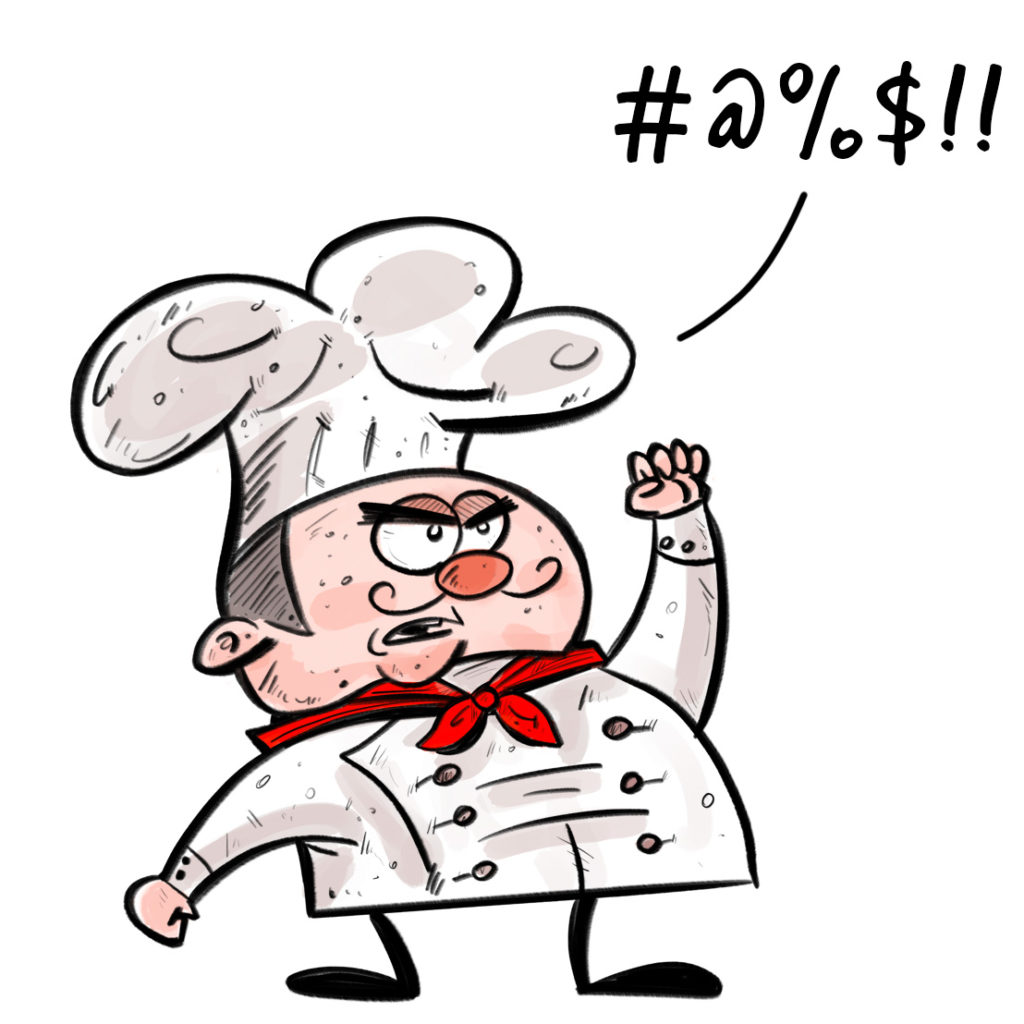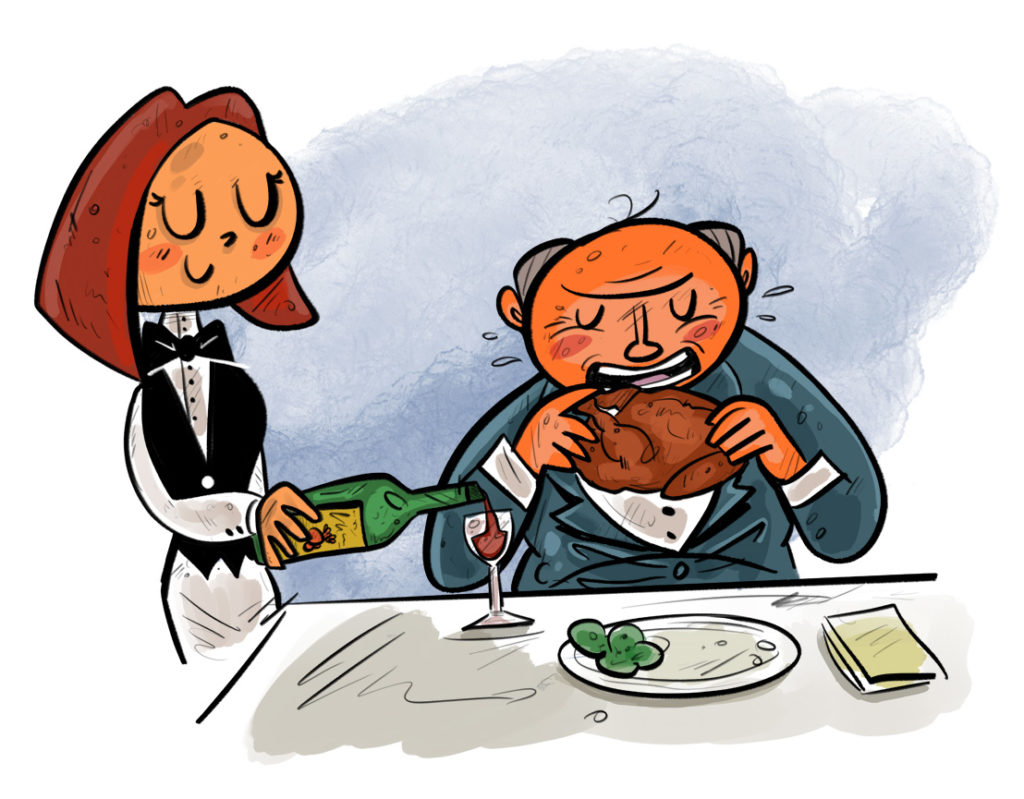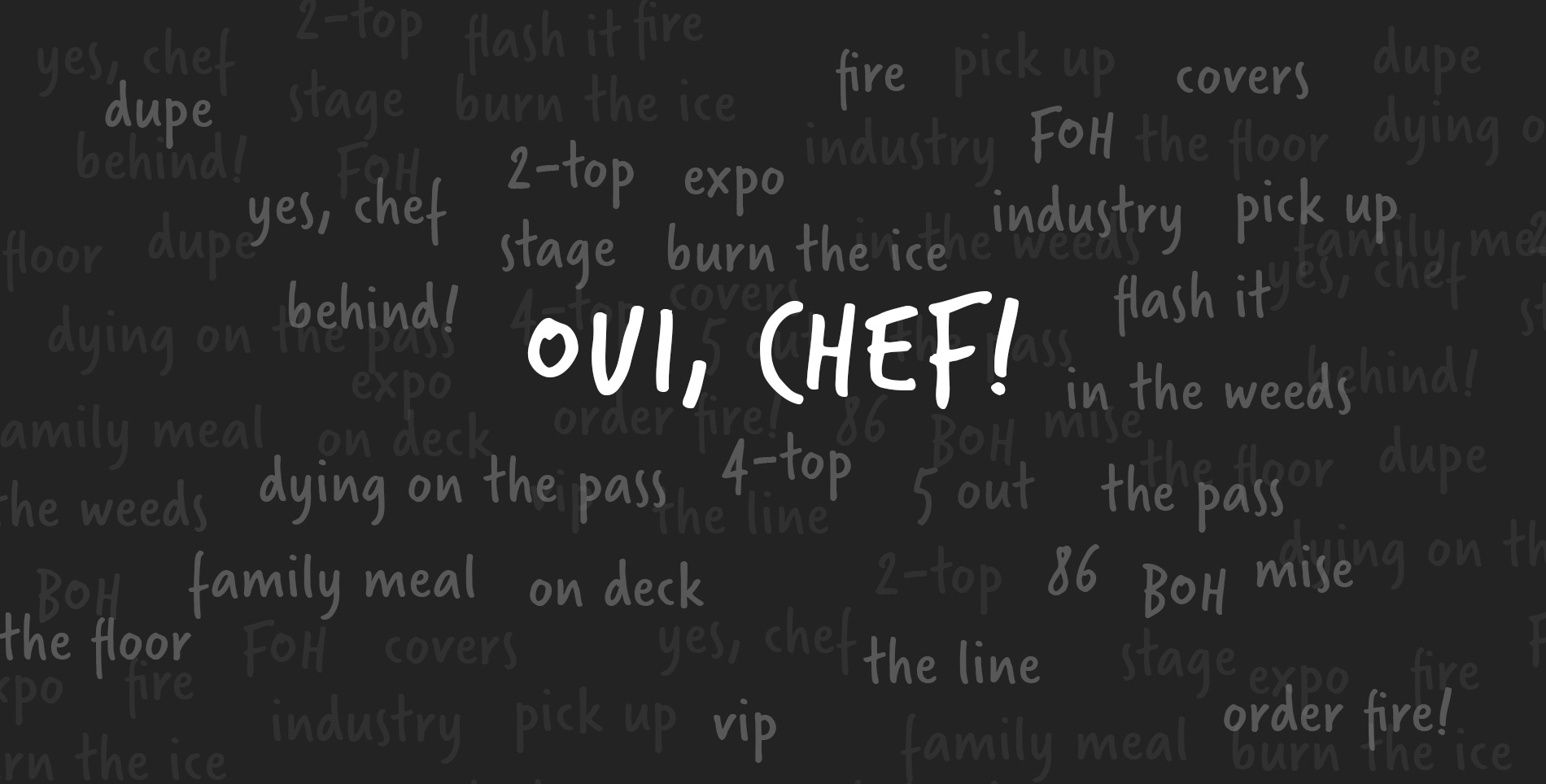After a lifetime of giving kitchen tours, I can say the thing the strikes people most about a professional kitchen isn’t the heat, the speed, or the size; it’s the moment an order comes in. The printer makes its little hum and click. The chef pulls the ticket from the machine, straightens it in his hand, and with a firm, confident voice calls out, “Order in. Two tasting.” Without a moment’s pause, in one loud, clear, singular voice the kitchen team replies: “Oui, Chef!” And the kitchen returns to silence. In just four little words—followed by two in return—a whole conversation is had, a myriad of tasks assigned, and a cascade of actions follow.
Professional restaurant kitchens utilize the brigade structure, a French system of organization based on army ranks—its generals and soldiers. All systems found in the kitchen are designed to best organize the potential chaos of a service rush, much like that of battle. Everyone is to have a clear understanding of place, so when push comes to shove each performs their role, allowing the team to succeed.
What receives less attention is the structure of a restaurant relies heavily on carefully chosen words that communicate orders, needs, dangers and beliefs. What varies is the clarity of the vernacular and the tenacity of its punch.

For Camaraderie & Practicality
For the majority of us, picking up that language is a rite of passage. On my first job as a host in a nice restaurant in Colorado, I entered the kitchen to a host of words I knew, but in a context that made no sense. I had so many questions. What is this four top? Why do they keep saying deuce? Who is taking a turn? What is this girl calling a double seating? Why does this guy keep screaming corner every time I walk around one? Why is that cook telling me there are eighty-six chickens? What does it all mean, and why is everyone getting so excited about it?
I studied the terminology as intently as I did my new position. I figured if I could speak the language, then the servers wouldn’t hate me so much when I inevitably triple-sat them, or the cooks would be a little more forgiving when I sat a walk-in twenty minutes past last seating. I worked hard to pick up the lingo, to carry it off casually and confidently, both in service and at the bar when we shared beers after. The same way I would all too casually—but with just the right amount of confidence—order a pitcher of beer and pray like hell that the owner of the bar didn’t remember I was nineteen. I got ambitious, dropping lines like, “Oh my god, did you see the deuce on forty-two? They camped out for three hours over those drinks. We had to last call them and turn the lights up.”
I’ve always been a pretty quick study; this turned out to be no different. Then one day, I went in to our regular bar and ordered a pitcher and a new bartender looked at me sideways and asked for my ID. As I began to turn pink, the owner shouted from behind the fryer on the far side of the bar: “Chad, she’s good. She’s industry.” Another new term to me, but I understood it immediately and beamed back toward the fryer.

To Form and Reinforce Philosophy
A few years and a couple of restaurant management positions later, I moved to New York City in search of a new challenge, and began work at my first Michelin-starred restaurant. I’d taken over wine, beer and cocktail programs since, accumulating a slew of additional terms to my lexicon. But I knew there would be a different language in this new setting, so I had been studying. I knew names (of chefs, of press, and of accolades we’d lust after), I knew the farms from which we proudly sourced, the authors and publications I should quote, and the culty wines I should be excited about (as well as the fact that culty wine was a thing). Early days working at that restaurant was a kind of boot camp; I worked twelve-hour shifts and then studied flashcards on brunoise and brûlée and bonbon until I fell asleep sitting up. I went through a harried and succinct culinary school training in the span of a few months, and spent every family meal standing, stuffing my face, reading Harold McGee aloud to my coworkers.
What I realized one especially memorable family meal though, was this wasn’t just a different language in the dining room; it was throughout the restaurant. When it came time to clean up after the team dined, and there were three tasks for three people: to put the food away, to sweep the floor, and to wipe the counter where the food had been. In any restaurant, chef towels are a valued commodity—and three Michelin stars did not change that fact. Each day, those on wipe-down duty had to ask one of the cooks to borrow his or her towel, and then return it to them. For this reason, I loved sweeping. Anything that didn’t require me interrupting the cooks.
But on this day, I got stuck with wiping. I looked around the kitchen at the commises and chef de parties in their crisp white jackets and clean blue aprons, heads down and intently focused, clearly not wanting to be disturbed. From the corner of my eye, I spotted a cook with his head in one of the tidy, highly organized herb fridges. I walked over, and at a volume just above a mumble, I said “Chef, could I borrow your rag quickly to clean up family?”
At full volume, with an eye to the rest of the kitchen to make sure everyone would hear, he responded. “A rag? Sorry, chef, we don’t have rags here. You can borrow my towel though, chef.” Bowed heads snickered and glanced sideways at my beet-red face as I scrubbed the already-shining silver countertop and scuttled out of the kitchen.
As I said, I’m a quick study. I have never used the word rag again. Not even at home.
Whereas previously I’d learned the language of restaurants for the sake of efficiency and clarity, this next phase of fluency was all about philosophy. Carefully choosing words—the way you speak about your team, your guests, your role, your tools—reflects and reinforces a feeling about each. How can you respect your team members washing dishes when you believe they spend twelve-hour days in a placed called the “dish pit”? Would you want to work in a pit? Could you be proud to work in a pit? Likewise…
We call them guests, not customers, because our interaction is more than a transaction.
We say dining room and kitchen, rather than front of house and back of house, because we are one house—we work together with the same goals.
We don’t say VIP because everyone is very important.
My learning curve was like an old rollercoaster. I tick-tick-ticked up the track those first few weeks, terrified of that inevitable plunge, of saying the wrong thing, making the wrong move, breaking an as-yet-unknown rule, or finding something previously innocuous—like a rag—had become as offensive as an ugly curse overnight. I listened carefully. I picked up on taboo words, but also noted the repetition of appreciated terms. I learned to move with a “sense of urgency”—at the fastest possible clip that could still technically be considered walking, always ready to anticipate three moves ahead for myself, or the needs of the expediter or chef.
But it was in this job where I truly learned the power of words to transform thinking. The language of that restaurant clearly communicated a deeply held regard for tools and materials. The leftovers from cutting vegetables or meat was called trim, never scraps. Scraps go in the trash; trim is used for sauces and family meal—never wasted and just as valued as the other cuts. By reinforcing this language, I began to see the philosophy emphasized. And from it, a team that doesn’t waste product, even when a manager isn’t looking. It saves money for the restaurant and creates a respect that radiates to the plates, glassware, even the kitchen itself. I watched language create self-enforcing standards; the entire team is treating the restaurant with respect and caring for its condition, instead of being careless or wasteful, and simply hoping to not be caught.

To Teach
I left that restaurant and took a deep dive into the language of product. I studied so I could speak intelligently about the brix content of vegetables, the nuances of biodynamics, the challenges of organic certification, the importance of crop rotation and whether sheep followed chickens or chickens followed sheep to create the best soil. Over time, I spoke about farmers with the familiarity of an uncle, I knew the department heads at agriculture universities, and I frequently responded guests’ questions regarding dishes with, “Let me know if I get too nerdy here…”
While I still strongly used words as reinforcement in the restaurant, snapping a sharp “guest” over a new server speaking about “How to tell a customer about the brassica family,” I found more of my attention was now in teaching the team to translate our terms to guest-friendly language. How do we convey the history, the science, the ethics, and the thought process behind the food to our guests—while still allowing them to enjoy their anniversary? How can I teach a server to explain how foie gras is created without gavage, given that the word gavage and the phrases used to define it, like force feeding, will turn a guest off from the very food about which we’re speaking?
It was again a lesson in philosophy. When the team truly understood, not just memorized, why the food was better—better for the farmer, better for the soil, better for the animal, and most importantly, tasted better—they could eloquently communicate that concept to the guest. Often, it was about less words—about letting someone enjoy their spinach, only telling them why it was so sweet when and if they asked.
Over the years, I became fluent in this language too. I could speak it, and also act as an instructor. As people joined the team, I supplied the words we used to convey our philosophy. But a restaurant is nothing if not a series of new challenges—most of which come just when you begin to feel most confident.
During my tenure, the chef mentioned off-handedly he had been thinking about a month-long, pop-up restaurant-inside-the-restaurant focused on food waste. On the less-pretty, the wrong-shaped cuts the butchers and fishermen took home to eat because they couldn’t sell them. On the food currently going in the dumpster, being thrown back out to sea, being picked apart and passed-over.
Then suddenly it was more than an idea—it was happening, and it certainly was a challenge in every way. But not least of all, a major hurdle was language. How do we talk about waste in an appetizing and exciting way? How do you tell these stories in a way that never evokes the image of a dumpster? We worked with the team to focus on speaking about grandma’s recipes—peasant food, fisherman food, farmer food—the ways we, as a global culture, have always found to use every part of the plant and animal. To escort the guest outside of grocery store aisles, to see what the food chain really looks like, and most importantly, to make the dishes sound delicious and appetizing. It was, like all challenges, also an opportunity to create a new way to communicate, to change the way our diners could imagine less common ingredients or preparations, to give them a language for that food, and to create happy, satisfying memories from the seemingly unfamiliar.
For the Future
Today, I run a new restaurant, and when I sat down two years ago to write the service manuals and handbooks for opening, I considered them not as legal documents regarding uniforms, time and attendance. And also not as manuals of standardized steps of service for managers to remind staff the way we do things. Instead, I looked at it as writing our new language. As I set down the words we as a restaurant would use, I was forming our philosophy; I was committing to paper our beliefs and our values, and what I hoped they would become.
As our staff sat down that first morning we opened, and I heard myself and our managers break down how we do and talk about things—the names for the roles (for instance, why we refer to someone a kitchen server, not a food runner), and the way we discuss guests. We began to learn our new language—a dialect with roots in many restaurants, but with carefully chosen words that make a set of beliefs clear. We were teaching the team how to offer water, but also how to make guests feel comfortable as soon as they sit, regardless of what money they’d spend. We were teaching the team how to read a soignée (the small ticket of information about each reservation). We were teaching side work, and also the importance of shaking in and out with managers and the rest of the team each day as a sign of respect and acknowledgement.
Several years later, the words we selected—supported by immense effort and cognizance—have created a culture and restaurant that lives and breathes the philosophy we hoped would come to life. When the words are chosen well and the language is universally spoken, it does the work. The words communicate the team’s beliefs. They both ask the questions and answer them for new team members. The challenge of language, like all oral traditions, is it mutates and dilutes and changes, so it is always our job to both maintain and look for ways to evolve the language, to find new ways to speak about the restaurants we love and teams we respect, down to the last word.



Our comments section is for members only.
Join today to gain exclusive access.